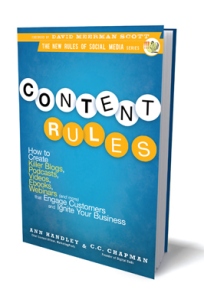I was fortunate to receive a copy of “The New Rules of Lead Generation“, by David T. Scott, for review. As I read the book I couldn’t help but notice that the author not only goes straight to the point (which is refreshing), he also shows a good deal of experience illustrating each lead generation tactic with clear examples.
The author, David T. Scott, is the founder and CEO of Marketfish, a data management and lead generation platform. Prior to Marketfish, David served as VP of Marketing for PeopleSoft and Intermec, and also has Boston Consulting Group and GE in his resume. His solid business background shows that he is not just a “consultant”, “marketing guru” or some “speaker”.
But is this book for you? I hope the following review helps you make up your mind.
New and Old Rules
First, I’ve got to say that the title left me a bit uncertain. I have read the other David Scott (the one with Meerman in the middle) book “The New Rules of Marketing and PR” and know that he has started a series of “new rules” books and eBooks. So my first impression was that David T. Scott (or his publisher) was trying to jump on the well known “new rules” title created by another author and take advantage of it.
Leaving the issue of the title aside, the book doesn’t focus only on “new” lead generation tactics like social media and online advertising but instead it gives you a more comprehensive roadmap for implementing a lead generation program at your company using both tried-and-true lead gen tactics like direct mail and cold calling and social media advertising, display advertising, and search engine marketing.
The Basics and More
The book starts off talking about basics of lead generation, how to develop your strategy, and gives an overview of each tactic. The first 5 chapters set up the stage and are great for someone new to marketing or that is interested in getting a better understanding of lead generation. The remaining 11 chapters go deep into each tactic.
Planning Your Strategy
According to David, there are 5 steps to a successful lead generation program:
1. Determine and plan your approach
2. Research and discover your target customer
3. Build your assets
4. Execute your test campaign
5. Measure
And he adds a ‘sixth’ step: Repeat!
Sounds simple and trivial, but unless you and your marketing organization are in sync as to what needs to get done to setup your lead gen program, it will be tough to get good (and measureable) results.
One thing I really liked was that he mentions in several places throughout the book the importance of coordinating your lead generation tactis and testing. He says “You are constantly testing and anlyzing your results to see which lead generation tactic works best for you”. This is important, because you don’t want to go ahead and spend money on certain tactics just because your competitor is doing it or because it is being talked about in the media. Testing is important if you want to improve your lead gen results.
Lead Generation Tactics
The 7 lead generation tactics that the author believes are the most successful ones are:
- SEM
- Social Media Advertising
- Display Advertising
- Email Marketing
- Cold Calling
- Direct Mail
- Trade Shows
There’s one chapter for each of the tactics. Although you won’t get a lot of deep information on the many ways to use a certain tactic, it will get you up to speed on what exactly each one is and how it is used.
Lead Gen Basics
As I said earlier, this book focuses on the basics of lead generation. Having said that, I think the book is missing a couple of important topics. First, the author presents the reader with the AIDA framework, a model that every marketer should know. It would have been better, however, if he also had introduced the reader to the SiriusDecisions demand waterfall model that is becoming prevalent in larger B2B organizations and a key component in any discussion about lead generation tactics.
Another point I think was not stressed enough in the book is the importance of defining what exactly constitutes a lead and how this seemingly simple concept can be the cause for a great divide between sales and marketing, especially because the book is aimed not at the experienced marketer but the beginner.
Finally, is not until chapter 5 that the author talks about the marketing and sales funnel, discussing the concepts of Marketing Qualified Lead, Sales Accepted Lead, Sales Qualified Lead, and Sales Qualified Opportunity. I think that it would have been better to have brought up the funnel earlier in the book to set the stage for how different lead generation tactics should help drive and move leads from one stage to another.
Regardless of these issues, the book is still a good source of information for those starting off in their marketing careers.
For more information about the book, check it out on Amazon and on the book’s website.



 Posted by Daniel Kuperman
Posted by Daniel Kuperman 









